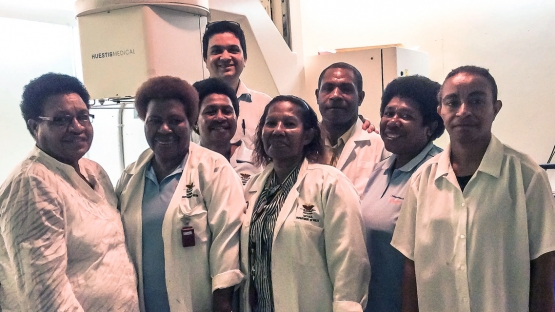Papua New Guinea, one of the IAEA's newest Member States, is getting ready to use nuclear techniques in agriculture, environmental monitoring and cancer treatment, the country's officials said.
"There are many crucial problems we can address ably and effectively with nuclear techniques," said Goa Tau, the country's National Liaison Officer to the IAEA, who participated in a workshop to design projects with the IAEA late last month.
"The IAEA can help us enormously with economic concerns, nutrition issues, security and safety, and can assist us in building our country's capacity," Tau said.
This will be Papua New Guinea's first-ever technical cooperation project with the IAEA, which will be using nuclear techniques in a diverse set of sectors.
"The most important thing we want to achieve with this project is to demonstrate that nuclear techniques can be used for various peaceful purposes. In this way we will raise public awareness about the benefits of nuclear technology and how the IAEA can help us address many crucial problems," said Tau. "During this meeting IAEA experts assisted us in identifying and defining precise and realistic objectives for the project. We will go home with a much clearer vision and plan about how to apply nuclear technology in the future as efficiently and effectively as possible."
Radiation technology helps fight cancer
Papua New Guinea, which has a population of seven million, has only one radiotherapy centre and two radiation oncologists. A key objective of the project is to strengthen the existing radiotherapy infrastructure and to train experts in the cancer centre at the Angau Memorial Hospital in Lae, the country's second largest city. Organizing scientific visits to the IAEA and other advanced laboratories are the most important objectives at this initial stage, Tau said.
"Capacity building is a priority in this project," said Massoud Malek, who manages the project at the IAEA. "As Papua New Guinea is one of our newest Member States, we are helping them to build the foundations for using nuclear technology, which means we assist them to evaluate what is required, what resources are available within the country and for which issues they can get Agency's support," he explained.
Monitoring the environment
In an effort to strengthen the fisheries industry, monitoring of the marine environment using nuclear techniques could be used. Environmental pollution monitoring in the country's coastal waters is also very important, as any contamination could spread to neighbouring countries quickly, Malek said.
To help the country's government achieve these goals using nuclear applications, the IAEA will assist in organizing workshops and training sessions with international experts.
Devastating pests can be combated using nuclear technology
Nuclear techniques could also help the country fight the Cocoa Pod Borer moth, which had been damaging cocoa plantations since 2006. Cocoa, one of the largest agricultural export items, is crucial for the country's economy, and the moth does affect the livelihood of a large number of farmers. The government had been trying to eradicate the pest completely from the infested plantings, but the moth re-emerged and by 2008 was creating wider havoc.
The IAEA has long been developing and applying an environmentally friendly technology called the sterile insect technique to control the population of pests, for example the tsetse fly and the fruit fly in many Member States.
"We did not know about this particular use of nuclear technology before we joined the Agency," Tau said. "The IAEA presented us its work in this area and we hope that we can use the same technique to control and suppress the population of the Cocoa Pod Borer moth. In our country, the incomes of entire families depend on the cocoa plant, and that is why it is crucial to fight this pest," he said.
Another nasty insect that affects cattle is the harmful buffalo fly, which the government hopes to combat using nuclear techniques as well, he added.
Establishing a national radiation regulator
The prerequisite for all the projects using nuclear techniques is a regulatory infrastructure for the control and safe management of radioactive sources. The IAEA will assist Papua New Guinea in establishing an adequate and sustainable national regulatory infrastructure in accordance with international standards and guidelines.
The projects under discussion will materialize in 2016-2017 and will help the country greatly, Tau said. "Although we just got started, we are already looking into different scenarios and into expanding various areas."



